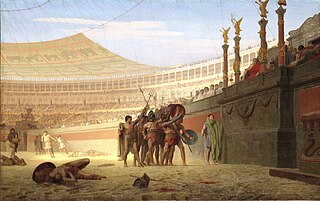 W
WA gladiator was an armed combatant who entertained audiences in the Roman Republic and Roman Empire in violent confrontations with other gladiators, wild animals, and condemned criminals. Some gladiators were volunteers who risked their lives and their legal and social standing by appearing in the arena. Most were despised as slaves, schooled under harsh conditions, socially marginalized, and segregated even in death.
 W
WThe arbelas was a type of ancient Roman gladiator. The word is a hapax legomenon, occurring only in the Oneirocritica of Artemidorus, a Greek work on dream interpretation that discusses the symbolism of various gladiator types. It may be related to the Greek word arbelos (ἄρβηλος), a cobbler's semicircular blade used to cut leather similar to an ulu.
 W
WAvē Imperātor, moritūrī tē salūtant is a well-known Latin phrase quoted in Suetonius, De vita Caesarum. It was reportedly used during an event in AD 52 on Lake Fucinus by naumachiarii—captives and criminals fated to die fighting during mock naval encounters—in the presence of the emperor Claudius. Suetonius reports that Claudius replied "Aut nōn".
 W
WDamnatio ad bestias was a form of Roman capital punishment in which the condemned person was killed by wild animals, usually lions or other big cats. This form of execution, which first came to ancient Rome around the 2nd century BC, was part of the wider class of blood sports called Bestiarii.
 W
WDe Spectaculis, also known as On the Spectacles or The Shows, is a surviving moral and ascetic treatise by Tertullian. Written somewhere between 197-202, the work looks at the moral legitimacy and consequences of Christians attending the circus, theatre, or amphitheatre.
 W
WThe Gladiator Mosaic is a famous mosaic of gladiators measuring about 28 meters, dated to the first half of the 4th century. It was discovered in 1834 on the Borghese estate at Torrenova, on the Via Casilina outside Rome. The antiquities which reinvigorated the Borghese Collection after it had shrunk following the sale of much of the collection to Napoleon I.
 W
WThe gladiatrix is the female equivalent of the gladiator of ancient Rome. Like their male counterparts, female gladiators fought each other, or wild animals, to entertain audiences at various games and festivals. Very little is known about them. They were almost certainly considered an exotic rarity by their audiences. Their existence is known only through a few accounts written by members of Rome's elite, and a very small number of inscriptions.
 W
WA manica was a type of iron or bronze arm guard, with curved and overlapping metal segments or plates, fastened to leather straps, worn by Roman gladiators called crupellarii, and later optionally by soldiers.
 W
WThe naumachia in the Ancient Roman world referred to both the staging of naval battles as mass entertainment, and the basin or building in which this took place.
 W
WPollice verso or verso pollice is a Latin phrase, meaning "with a turned thumb", that is used in the context of gladiatorial combat. It refers to a hand gesture or thumb signal used by Ancient Roman crowds to pass judgment on a defeated gladiator.